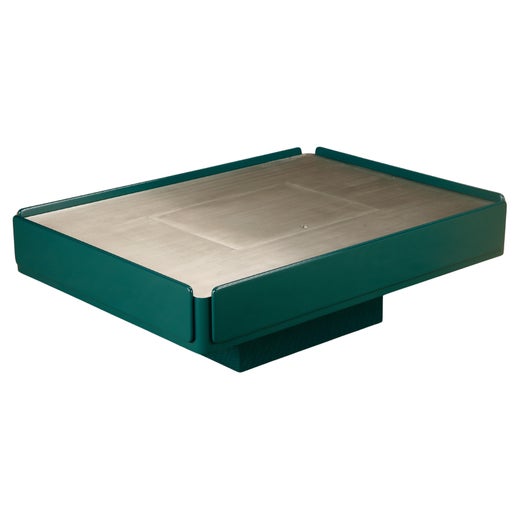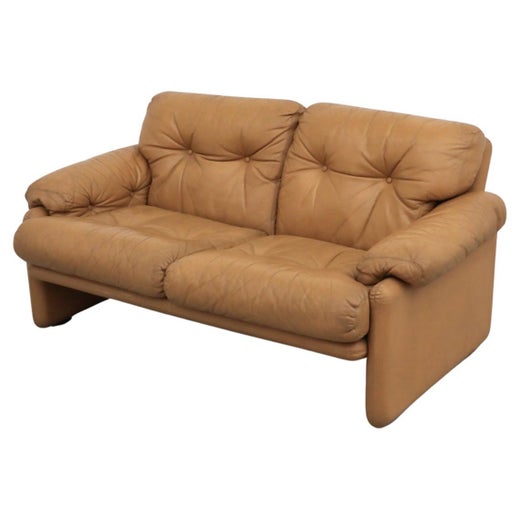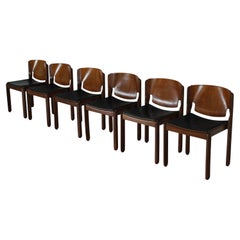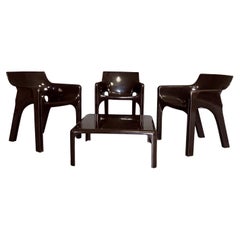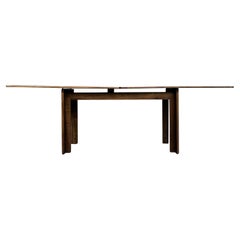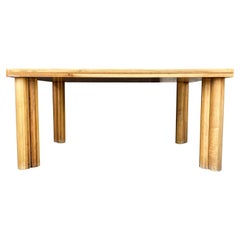Vico Magistretti Black Lacquered Tema Dining Table for B&B Italia, 1974
About the Item
- Creator:Vico Magistretti (Designer),B&B Italia (Manufacturer)
- Dimensions:Height: 28.35 in (72 cm)Width: 55.12 in (140 cm)Depth: 55.12 in (140 cm)
- Style:Mid-Century Modern (Of the Period)
- Materials and Techniques:Beech,Lacquered
- Place of Origin:
- Period:
- Date of Manufacture:1974
- Condition:Minor fading.
- Seller Location:Vicenza, IT
- Reference Number:1stDibs: LU8019243340822
Vico Magistretti
As one of the founding fathers of modern Italian design, prolific architect and industrial designer Ludovico Magistretti (known by his nickname Vico) was guided by his philosophy, “There is no excuse for bad design.” His architectural projects are widely revered, and an ingenious meld of form and function can be found in his stylish and deceptively simple table lamps, sofas, armchairs and other mid-century furnishings.
Born in Milan, Magistretti followed in the footsteps of his father and grandfather (both architects) to study architecture at the Polytechnic University of Milan. At the outbreak of World War II, he fled to Switzerland, and it was there he met his role model and mentor, renowned humanist architect Ernesto Nathan Rogers. Magistretti was inspired by Rogers’s vision to revive postwar Italy, and they collaborated on several reconstruction projects. Among Magistretti’s first architectural designs is a “poetic” round church, which he created for the QT8, an experimental Milanese neighborhood.
When Magistretti returned to Milan in 1945, he worked at his father’s architectural firm. It wasn’t until the early 1950s that he expanded his talents into design while working with furniture artisans.
In the 1960s, Magistretti began his 30-year working relationship with famed entrepreneur Cesare Cassina of the Cassina furniture manufacturing company. In their design approach, the two men shared a vision of the relationship between modernity and tradition and enjoyed a close bond (Magistretti designed Cassina’s luxurious villa in 1965). However, their friendship was not without contention.
Legend has it that upon seeing the prototype for Magistretti’s Maralunga sofa, Cassina hated it so much that he punched it, breaking the back of the sofa, which crumpled into itself.
“Right, great, it looks perfect to me like that,” an unfazed Magistretti allegedly responded, and the Maralunga’s slumped, adjustable-height backrest was born. Incidentally, the Maralunga sofa won Italy’s Compasso d’Oro award as did his Eclisse lamp for Artemide and his Atollo lamp for Oluce.
Magistretti died in 2006, but his designs live on in galleries, museums and private residences and offices around the world.
Find a range of vintage Vico Magistretti furniture and lighting on 1stDibs.
B&B Italia
In 1966, Piero Ambrogio Busnelli cofounded C&B Italia, a modern Italian furniture manufacturer, with Cesare Cassina in northern Milan. From the outset, Busnelli and Cassina set about recruiting the most talented modernists in Italy to conceive of creative furnishings manufactured in modern ways. In the early 1970s, the company split, with Cassina founding his own eponymous firm and Busnelli taking leadership of what became B&B Italia.
For decades, Busnelli cultivated relationships with the world’s best design talent, resulting in furniture pieces that remain iconic today — be they Gaetano Pesce’s outwardly curvaceous Up seating (made for C&B, reintroduced by B&B) or tables from industrial designer Paolo Piva, each more sophisticated than the next in their geometrically complex steel-tube bases. B&B Italia earned four prestigious Compasso d’Oro design awards: in 1979 for Mario Bellini’s Le Bambole, in 1984 for the Sisamo wardrobe system by Studio Kairos, in 1987 for Antonio Citterio’s modular Sity sofa and, in 1989, the first award given to a manufacturing company itself.
Other notable names who designed for B&B Italia over the course of its 54-year history include Patricia Urquiola, Naoto Fukasawa, Zaha Hadid, Ettore Sottsass and Vincent Van Duysen, to name a very few. And while these names bring star power to the B&B brand, in many cases, it was B&B Italia who helped usher in their celebrity, fostering a wave of design talent on the world stage.
The company’s forward-thinking vision manifested in its own headquarters, too: In 1972, B&B Italia tapped architects Renzo Piano and Richard Rogers to design a steel-framed, postmodern-style home for the brand, whose crisscrossing metal exoskeleton is reminiscent of the pair’s Centre Pompidou in Paris, which was built at roughly the same time. Now, B&B Italia manages a contract division and outdoor section as well as its residential arm, and it also controls production for Maxalto, a brand spun out with furniture designs by Antonio Citterio.
At 1stDibs, find a range of vintage B&B Italia furniture — including sofas, cocktail tables and more.
You May Also Like
Vintage 1970s Italian Modern Dining Room Tables
Plastic
2010s Italian Mid-Century Modern Dining Room Tables
Glass
2010s Italian Mid-Century Modern Dining Room Tables
Glass
Vintage 1960s Italian Mid-Century Modern Dining Room Tables
Wood
Vintage 1960s Italian Mid-Century Modern Dining Room Tables
Walnut
Mid-20th Century Italian Mid-Century Modern Dining Room Tables
Concrete, Marble
Vintage 1970s Italian Organic Modern Dining Room Sets
Bamboo
Mid-20th Century Italian Mid-Century Modern Dining Room Sets
Rush, Oak
Vintage 1980s Italian Post-Modern Side Tables
Marble, Metal
Vintage 1980s Italian Mid-Century Modern Dining Room Tables
Stainless Steel
More From This Seller
View AllVintage 1960s Italian Mid-Century Modern Chairs
Leather, Walnut
Vintage 1970s Italian Space Age Armchairs
Fiberglass
Vintage 1960s Italian Mid-Century Modern Dining Room Tables
Walnut
Vintage 1970s Italian Mid-Century Modern Dining Room Tables
Walnut
Vintage 1960s Italian Mid-Century Modern Chairs
Beech, Straw
Vintage 1980s Italian Post-Modern Dining Room Tables
Aluminum
Recently Viewed
View AllRead More
Rooms We Love: 11 Splendid Living Rooms
Common wisdom used to declare the kitchen the hub of the house. These days, the living room seems to have assumed the role of domestic focal point. Unlike the Victorian parlor, stiffly furnished and reserved for guests, today’s living room is a central place for reading, conversation and, well, living, with furnishings that lend themselves to both casual lounging and elegant entertaining.
Vincent Van Duysen Imbues Minimalism with Warmth
The Antwerp-based designer lends his unique touch to homes, boutiques and offices in Belgium, the United States and Germany, as well as furniture for B&B Italia and Molteni.
